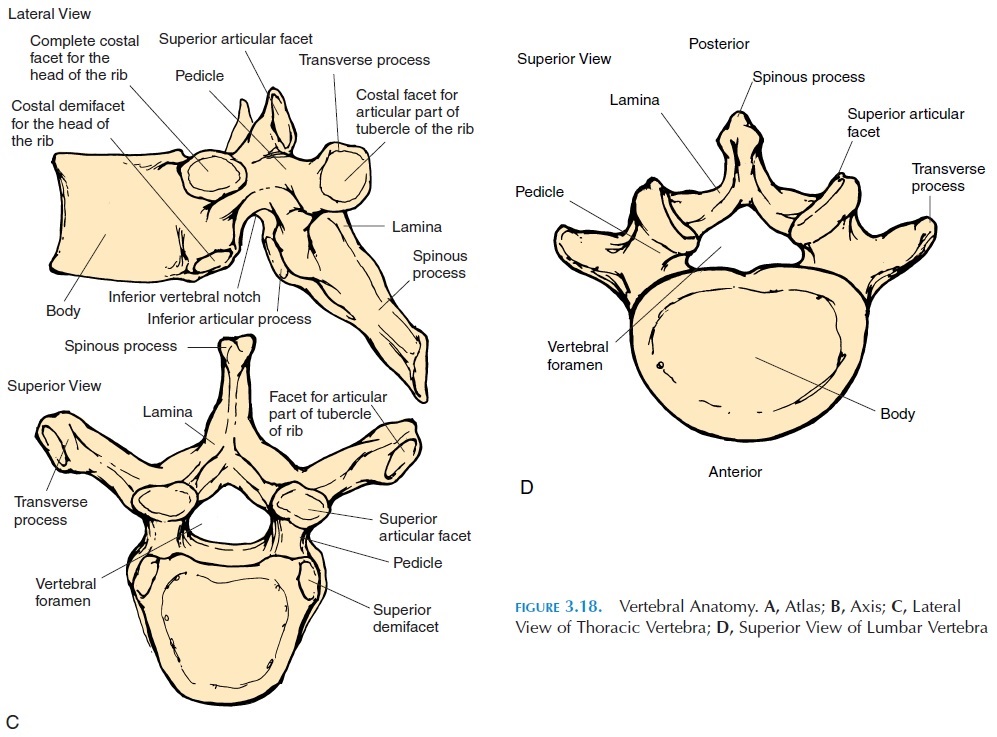Chapter: The Massage Connection ANATOMY AND PHYSIOLOGY : Skeletal System and Joints
Vertebral Regions and Spinal Curvatures - The Vertebral Column

Vertebral Regions and Spinal Curvatures
The vertebral column is subdivided into the cervical (7 vertebrae), thoracic (12 vertebrae), lumbar (5 ver-tebrae), sacral (1 vertebrae), and coccygeal (1 verte-bra) regions. Although the cervical, thoracic, and lumbar consist of individual vertebrae, the sacrum is formed by the fusion of 5 individual vertebrae and the coccyx is formed by the fusion of 3–5 vertebrae. For ease, the vertebrae are labeled according to the position in individual regions (e.g., the 7th cervical vertebra is labeled C7; 2nd thoracic vertebra as T2; and so on.

The individual vertebra of the vertebral column are aligned to form four spinal curves (see Figure 3.17)—the cervical, thoracic, lumbar, and sacralcurvature. The thoracic and sacral curvatures havethe concavity of the curve facing forward.


Each vertebra consists of three parts: the body,vertebral arch, and articular processes (see Figure3.18). The body is thick, disk-shaped, and located an-teriorly. The bodies are interconnected by ligaments. Interspersed between each vertebra are fibrocartilage pads called intervertebral disks . Two vertebral arches lead off posterolaterally from thebody. The two, short, thick processes leading off from the body are known as pedicles. The pedicles have depressions on the superior and inferior surfaces (vertebral notches). The pedicles join the laminae, the flat, posterior part of the arch. These arches meet posteriorly to enclose an opening called the vertebralforamen. Because the vertebrae lie on top of eachother, the successive vertebral foramen form a verte-bral canal. The spinal cord lies in the vertebral canal.Laterally, a small foramen is formed where the notches on the pedicles of successive vertebrae align. This is the intervertebral foramen. The spinal nerves exit from the vertebral canal through these foramen. Posteriorly, each vertebra has a projection called the spinous process. This forms the bumps that are seen in the middle of the back in a lean indi-vidual. The most prominent of these bumps at the base of the neck indicates the location of the C7 spin-ous process. C7 is, therefore, called the vertebraprominens (also see Fig. M 3).
A large elastic ligament, the ligamentum nuchae, is attached to the spinous process of C7. From here, it continues upward, attached to the spinous processes of the other cervical vertebrae before it reaches the prominent ridge on the occipital bone, the external oc-cipital crest. This ligament maintains the cervical cur-vature, even without the help of muscular contraction. If the head is bent forward, this elastic ligament helps bring the head to an upright position.
Transverse processes project laterally on bothsides. The processes are sites for muscle attachment. Each vertebrae has articular processes that project inferiorly (inferior articular process) and superi-orly (superior articular process). This is the area where adjacent vertebrae articulate. The superior ar-ticular processes of the lower vertebra articulate with the inferior articular processes of the vertebra lo-cated above. The articulating surface of the processes are known as facets.
Related Topics